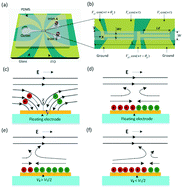A novel micromixer based on the alternating current-flow field effect transistor†
Abstract
Induced-charge electroosmosis (ICEO) phenomena have been attracting considerable attention as a means for pumping and mixing in microfluidic systems with the advantage of simple structures and low-energy consumption. We propose the first effort to exploit a fixed-potential ICEO flow around a floating electrode for microfluidic mixing. In analogy with the field effect transistor (FET) in microelectronics, the floating electrode act as a “gate” electrode for generating asymmetric ICEO flow and thus the device is called an AC-flow FET (AC-FFET). We take advantage of a tandem electrode configuration containing two biased center metal strips arranged in sequence at the bottom of the channel to generate asymmetric vortexes. The current device is manufactured on low-cost glass substrates via an easy and reliable process. Mixing experiments were conducted in the proposed device and the comparison between simulation and experimental results was also carried out, which indicates that the micromixer permits an efficient mixing effect. The mixing performance can be further enhanced by the application of a suitable phase difference between the driving electrode and the gate electrode or a square wave signal. Finally, we performed a critical analysis of the proposed micromixer in comparison with different mixer designs using a comparative mixing index (CMI). The novel methods put forward here offer a simple solution to mixing issues in microfluidic systems.


 Please wait while we load your content...
Please wait while we load your content...